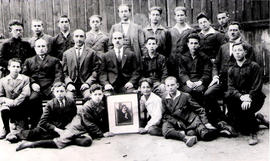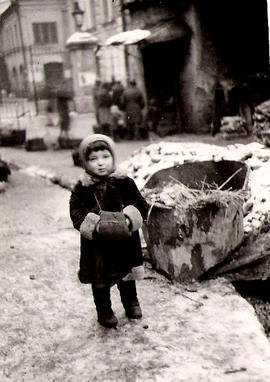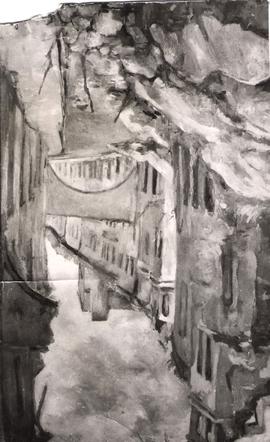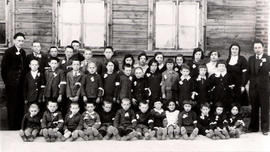- Series
- 2013-
The Vilnius Photograph Series includes four sombre photographs throughout the town of Vilnius, including a photograph of a near-empty street, a painting of another city street, a young child in the street, and an elderly man on the side of the road. With these photographs being taken quite close to the end of the interwar period, the sombre tone is appropriate, since at the brink of war, Eastern European Jews were suffering severe poverty and exclusion from society. Aside from these, there are also three photographs of Jewish organisations and clubs, including one Haskalah school photograph, a scene from an inter-Jewish school athletics event and a Jewish football team. With ever-increasing anti-Semitism and exclusion, Jewish community members would form their own organisations, which served as meeting points for Jews who were largely shunned in other realms of society and therefore unable to join mainstream organisations of a similar kind. This exclusion, primarily based on anti-Semitism, made these organisations necessary if Jews were interested in taking part in these activities, but also promoted an in-group sense of belonging in a highly community-oriented group.
Jewish people in Vilnius made made up a considerable proportion of the population, and contributed significantly to the economy mostly through their role as merchants, tradesmen and manufacturing owners. Vilnius was also known for its strong 19th century Bundist movement, and later an even stronger Zionist presence in the early 1900s whereby this town housed the Zionist Committee of Russia from 1905 to 1910. Economics and politics aside, Jews were perhaps strongest in their cultural and educational contribution in Vilnius. The Haskalah movement (Jewish Enlightenment) spread through the town and outwards from there, it was the seat/centre of the Torah for many years, it was home to many progressive thinkers and writers and also attracted similar talents to its cultural haven, and was known to be a particularly vibrant hub for Hebrew literature. [Source: https://www.yadvashem.org/yv/en/exhibitions/vilna/overview.asp].
The chaotic pattern in Eastern Europe and nearby regions in the first half of the 20th century – mostly as a result of the two World Wars – consisted of sporadic occupation, independence, and reoccupation of territories. Vilnius was part of the Russian Empire prior to World War I, whereby it flourished in many ways. In the year 1915, during the Yom Kippur period, Germany occupied Vilnius, bringing about widespread poverty and starvation, thereby eradicating the flourishing economy that existed here. Jewish folk were forced to work for Germans, and were treated with much cruelty, only inspiring further comraraderie among this community-oriented group. Jews supported one another in finding employment opportunities in the scarce market, and made strides in education and culture despite the harsh conditions. Immediately after WWI, there was a complex period of transition out of German rule when Germans retreated at the end of 1918. Polish citizens in Vilnius were given leadership roles, but this did not last long as the Bolshevik troops invaded and took control for a short period. In April 1919, Polish troops entered Vilnius, taking control and 'liberating' the town, although doing so with a fair amount of ill treatment of Jews. This 'liberation' saw the election of Jews to town council positions, but this was disrupted by another invasion by the Red Army in July 1920. Only one day later, Lithuanians entered the town and tried to occupy, but the Russians only handed over control to Lithuanians at the end of August 1920, with Lithuanians promising autonomy to Jews. Polish troops arrived and took control in that same year, conquering other leaderships and severing ties with Lithuania who had formed an Independent Republic by that point. Under Polish rule, the economy was stagnant and many Jewish community leadership positions were faded out, alongwith much emigration to America and other overseas countries. Throughout this hardship, Jewish education continued to thrive, with Jews fighting for rights and freedoms since only Polish high school diplomas were accepted initially, thus making it difficult for Jews to attend university, yet many Jewish students still managed to obtain a university education. Unfortunately, this tumultuous period lead to Vilnius losing its position as the home of Hebrew literature, but Yiddish certainly took an important position. Anti-Semitism was rife, worsened by internal divides between Socialist Bundists and Jewish Nationalist Zionists. At the beginning of World War II, as part of the agreement between Germany and the Soviet Union, a portion of Poland (including Vilnius) was occupied by the Soviet Union, who handed over control to Lithuania in October 1939. As war developed, the Soviet Union reoccupied Vilnius in August 1940, and Jews were treated with violence and exiled to Siberia in amny cases. Nazi Germany occupied Vilnius in June 1941, soon after which anti-Semitic measures were put into place. In collaboration with Lithuanian locals, Nazis orchestrated 5000 murders at Ponary forest in July 1941, and another 3500 there in August. The degree of local collaboration by Lithuanians speaks to the murderous anti-Semitism present here. In September 1941, two ghettoes where established in Vilna, with ghetto 1 being for those able to work, and ghetto 2 being for those who were to be killed almost immediately in Ponary, leading to around 40000 total deaths in that forest by the end of 1941. Ghetto 1 occupants were forced to work, and were periodically terrorized by killing sprees in the forest, or by transfers to other labour camps nearby. The large majority of the ghetto occupants were murdered, with only a few Jews left by September 1943 when the ghetto was liquidated. Those too sick to work were killed in Ponary or sent to Sobibor death camp, men who could work were sent to labour camps in Estonia, and women were sent to labour camps in Latvia. Similarly to the strength in culture and community before the Holocaust, there were instances of resistance in the Vilnius ghetto, inspired by organized movements that existed pre-WWII. [https://kehilalinks.jewishgen.org/vilna/vilna.htm]
The town of Vilnius is named as such in Lithuanian, as Vilna in Russian, as Wilno in Polish, and as Vilne in Yiddish. This town also has the moniker of being the "Jerusalem of Lithuania" according to a large proportion of East European Jewry, which seems appropriate considering the strides in Jewish culture and thought that Vilnius was home to.








